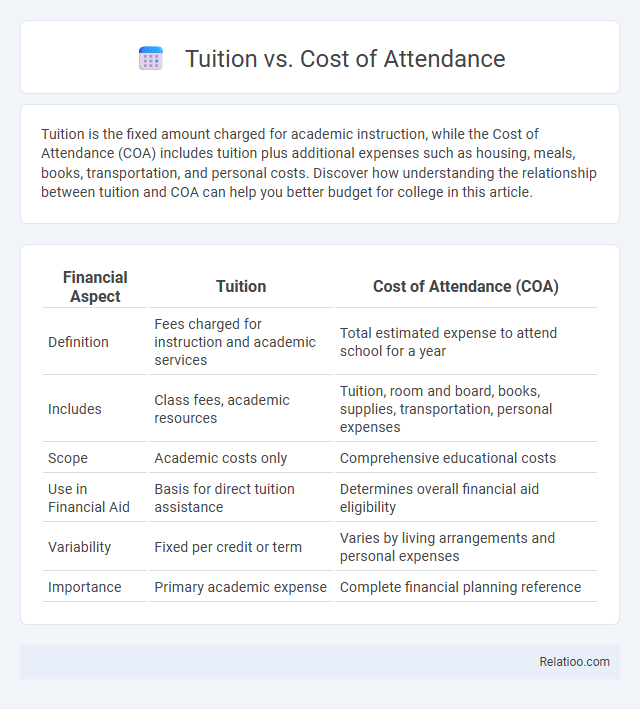Tuition is the fixed amount charged for academic instruction, while the Cost of Attendance (COA) includes tuition plus additional expenses such as housing, meals, books, transportation, and personal costs. Discover how understanding the relationship between tuition and COA can help you better budget for college in this article.
Table of Comparison
| Financial Aspect | Tuition | Cost of Attendance (COA) |
|---|---|---|
| Definition | Fees charged for instruction and academic services | Total estimated expense to attend school for a year |
| Includes | Class fees, academic resources | Tuition, room and board, books, supplies, transportation, personal expenses |
| Scope | Academic costs only | Comprehensive educational costs |
| Use in Financial Aid | Basis for direct tuition assistance | Determines overall financial aid eligibility |
| Variability | Fixed per credit or term | Varies by living arrangements and personal expenses |
| Importance | Primary academic expense | Complete financial planning reference |
Understanding Tuition: What It Covers
Tuition specifically covers the instructional fees charged by educational institutions for courses and academic programs. It excludes costs such as room and board, textbooks, supplies, and other personal expenses, which are part of the overall cost of attendance (COA). Understanding tuition helps students differentiate between direct educational fees and the broader financial requirements needed to attend college.
Defining Cost of Attendance: Beyond Tuition
Cost of Attendance (COA) encompasses not only tuition fees but also additional expenses such as room and board, books, supplies, transportation, and personal costs, providing a comprehensive estimate of the total financial requirement for a student to attend college. Tuition represents only the direct charge for instruction, while COA reflects the broader scope of expenses that impact a student's overall budget. Understanding COA helps students and families plan for the full spectrum of education-related costs beyond just tuition payments.
Key Components Included in Cost of Attendance
Tuition represents the core fee charged for instruction, but the Cost of Attendance (COA) encompasses a broader range of expenses including tuition, room and board, books, supplies, transportation, and personal costs. Your financial planning should consider the COA to fully understand the total amount needed to support your education beyond just tuition fees. Understanding these key components enables better budgeting and financial aid assessment to cover all aspects of your educational experience.
Tuition vs Cost of Attendance: What’s the Difference?
Tuition refers specifically to the amount charged by an educational institution for instruction or coursework, while Cost of Attendance (COA) encompasses tuition plus all related expenses such as housing, meals, books, transportation, and personal costs. Understanding the difference between tuition and COA is crucial for accurate financial planning, as COA provides a comprehensive view of the total expenses required to attend a college or university. Tuition is a subset of the Cost of Attendance, which helps students evaluate financial aid offers and compare the true cost of different institutions.
How Room and Board Affect Total College Costs
Tuition represents the base price charged for academic instruction, whereas cost of attendance (COA) encompasses tuition plus additional expenses like room, board, books, and fees. Room and board significantly increase total college costs, often accounting for nearly 30-50% of the COA depending on the institution and location. Understanding this distinction helps students and families better plan for the full financial commitment of college beyond just the tuition fees.
Fees and Additional Expenses to Consider
Tuition covers the base cost of instruction, but the Cost of Attendance (COA) includes additional expenses such as fees, room and board, textbooks, and personal expenses, providing a comprehensive estimate of your total financial commitment. Fees within the COA often encompass lab fees, technology fees, and student activity fees, which can significantly increase your overall expense beyond tuition alone. When budgeting, carefully analyze both tuition and these additional costs to avoid unexpected financial shortfalls during your academic journey.
Financial Aid Impact on Tuition and Cost of Attendance
Tuition refers to the direct fee charged by an institution for instruction, while Cost of Attendance (COA) includes tuition plus additional expenses such as housing, meals, books, and personal costs. Financial aid significantly reduces the net cost by applying scholarships, grants, and loans directly to tuition and sometimes to other components of COA, making education more affordable. Understanding the distinction between these terms helps students and families effectively plan budgets and maximize available aid resources.
Budgeting for College: Planning Beyond Tuition
Budgeting for college requires understanding the difference between tuition, cost of attendance, and total tuition payments. Tuition is the base price for academic courses, while the cost of attendance includes tuition plus fees, housing, meals, books, transportation, and personal expenses. Effective financial planning involves accounting for all components of the cost of attendance to avoid unexpected expenses beyond just tuition fees.
Comparing Colleges: Tuition and Cost of Attendance Analysis
When comparing colleges, understanding the difference between tuition and cost of attendance (COA) is crucial for evaluating your total financial commitment. Tuition represents the base fee charged for instruction, while the cost of attendance includes tuition, fees, room and board, books, supplies, and other living expenses. Analyzing both tuition and COA helps you make informed decisions by revealing the comprehensive expenses associated with each institution.
Tips to Reduce Out-of-Pocket College Expenses
Understanding the distinctions between Tuition, Cost of Attendance (COA), and your overall expenses helps you identify areas to reduce out-of-pocket costs effectively. Tuition covers only the direct academic fees, while COA includes tuition, fees, room, board, books, and personal expenses, giving a fuller picture of college costs. To minimize what you pay, explore scholarships, grants, in-state tuition options, community college transfers, and work-study programs tailored to reduce your financial burden during your education journey.

Infographic: Tuition vs Cost of Attendance
 relatioo.com
relatioo.com